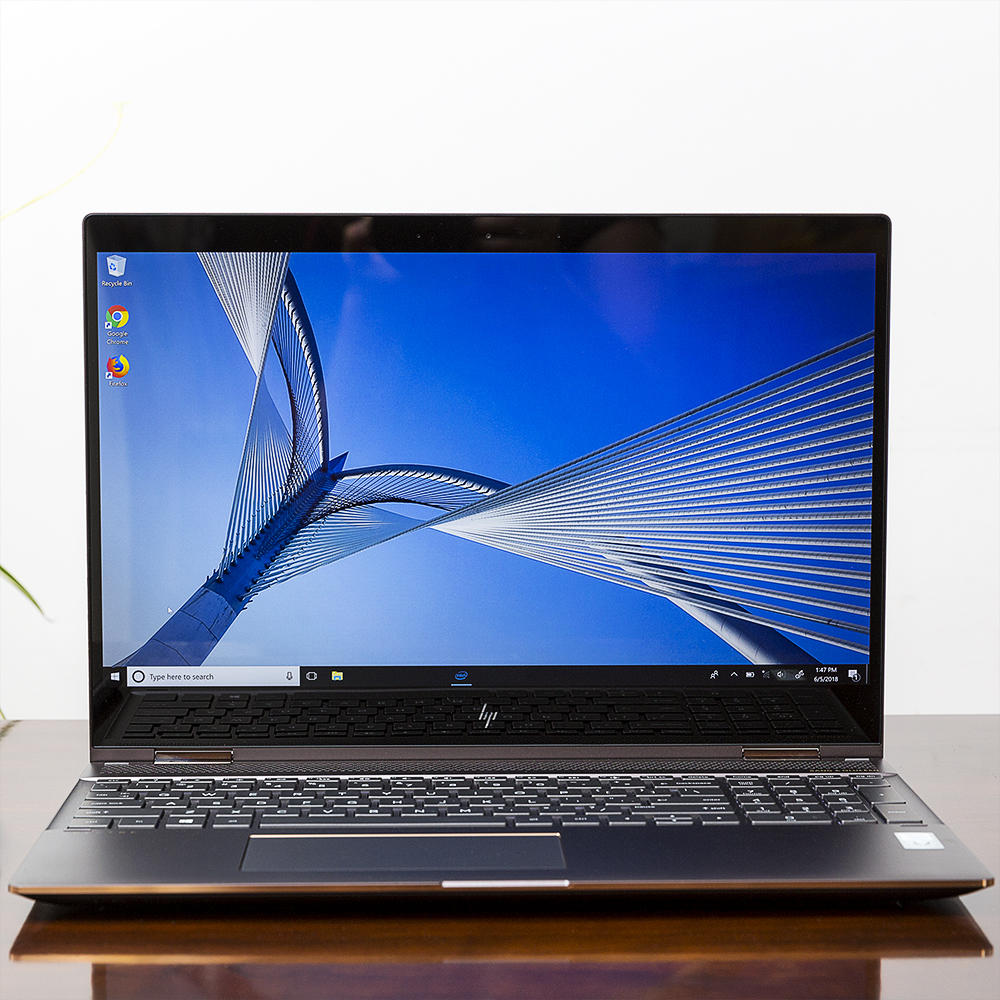HP SPECTRE X360 15: PERFORMANCE, PORTABILITY, AND COMPROMISE
/cdn.vox-cdn.com/uploads/chorus_image/image/60002383/akrales_180605_2621_0016.0.jpg) There’s a creative user base out there who want the complete package in a laptop: portability, power, a stylus, and a touchscreen. HP’s Spectre x360 15-inch is the latest laptop attempting to fulfill those needs.
There’s a creative user base out there who want the complete package in a laptop: portability, power, a stylus, and a touchscreen. HP’s Spectre x360 15-inch is the latest laptop attempting to fulfill those needs.This is by no means a budget laptop; the Spectre line has been featuring HP’s high-end offerings for a few years now and the price for this year’s model starts at $1,369. The well-equipped unit I’ve reviewed is $1,719, which isn’t cheap, but still less expensive than its famous competitor, a 15-inch MacBook Pro which starts at $2,399.
My review unit has a quad-core Intel Core i7-8705G processor (3.1GHz, TurboBoost up to 4.1GHz), 4GB Radeon RX Vega M discrete graphics, 16GB of DDR4-2400 RAM, a 512GB SSD for storage, and finally, the stand-out feature: a 4K IPS WLED touchscreen complete with Gorilla Glass. That list of specs is packed into a 2-in-1 chassis with a weight of 4.71 pounds and 0.76-inch in thickness.
If I were only evaluating the Spectre x360 15’s technical prowess, it would be an easy recommendation, but it’s a slightly different story when using it as my daily driver.
/cdn.vox-cdn.com/uploads/chorus_asset/file/11495367/akrales_180605_2621_0028.jpg)
The Spectre uses a completely metal unibody design, so it’s sturdy and quite attractive in nature, with copper edging and HP’s new “diamond-cut” edge for the rear-end of the laptop. It’s a nice aesthetic touch, but not game changing in any way. If you’re wondering about the keyboard and palmrest flexing under exerted pressure, unfortunately, the Spectre x360 suffers from both.
There appear to be some quality control issues with the Spectre x360 15, as well. During my test with HP’s provided review unit, I heard a rattle coming from the left fan vent when used in clamshell mode; the issue persisted in tent and tablet modes. To confirm this, The Verge purchased a retail model to compare, and it did not produce the same sound in any of the usage modes. It’s likely our review unit was defective, so Spectre x360 15 buyers should check their machine thoroughly upon setting it up.
Furthermore, the bottom plate and rubber feet don’t keep the laptop perfectly level on a desk; if pressure is applied to the corners of the palm rest, the whole chassis will wobble slightly. This was noticeable on both units we evaluated.
Also, despite the 4.71-pound stat on paper, holding the Spectre 15 with two hands feels cumbersome due to the large footprint. It can be used as a tablet thanks to the 360-degree hinge, but it’s far too heavy and unwieldy to use this way for any length of time.
/cdn.vox-cdn.com/uploads/chorus_asset/file/11495379/akrales_180605_2621_0051.jpg)
/cdn.vox-cdn.com/uploads/chorus_asset/file/11495381/akrales_180605_2621_0067.jpg)
Ports-wise, photographers will be happy to know the Spectre x360 comes with a full-size SD card slot. The rest of the available ports include a 3.5mm audio jack, two Thunderbolt 3 ports, HDMI-out, a singular USB 3.1 port, and power jack. There are three noteworthy additions to the port sides of this year’s Spectre x360 15: the power button, Windows Hello fingerprint sensor, and volume rocker on the left and right sides, respectively.
HP is betting that creatives — photographers, multimedia editors, artists, etc. — will like the Spectre x360 not only for its looks, but the fact it comes with a pressure-sensitive Windows Ink pen, powered by a AAA battery. However, it’s worth noting that nothing has changed regarding the pen for the past few generations of the Spectre x360.
/cdn.vox-cdn.com/uploads/chorus_asset/file/11495357/akrales_180605_2621_0106.jpg)
/cdn.vox-cdn.com/uploads/chorus_asset/file/11495351/akrales_180605_2621_0076.jpg)
/cdn.vox-cdn.com/uploads/chorus_asset/file/11495355/akrales_180605_2621_0074.jpg)
If you doodle something in Windows Ink, you’ll find that there aren’t any special functions mapped to the two buttons by default on the pen, other than erase. Overall it works similarly to a Surface Pen, but the included pen is not as precise as say, a Wacom pen and tablet combo, so anyone into serious drawing might opt for an external solution.
If you want something more capable, HP offers an optional Tilt Pen for $89, which has the same 1,024 levels of pressure, but adds a tail-end eraser, USB-C charging, and the ability to draw at an angle. But it’s still not as capable as a Wacom pen and tablet or even Microsoft’s latest Surface Pen.
Speaking of which, let’s talk about the screen. Yes, it’s true 4K (3,840 x 2,160 pixels) locked at 60Hz with 340 nits brightness, 282 pixel-per-inch and tons of vibrance. It’s a nice display to look at, however some Windows apps still struggle or look slightly out of place when scaled to the full 4K resolution.
Though compared to the big picture — it being for creatives — that’s all negligible, because the disappointment actually lies with the lack of 100 percent Adobe RGB color coverage. Yes, a display meant for creative power users who might be picky and most likely will edit colors, won’t have support for the full color spectrum of the Adobe suite.




No comments: